Nothing defines a custom ride like a one-of-a-kind paint job, but to many first timers, paintwork can be a daunting proposition. Have no fear! Laying down some custom color is like any other job in the garage—with a little know-how and the right set of tools, a professional quality, mile-deep paint job is well within your grasp.
Unsure of how much paint and primer you actually need to buy? Use this Paint Volume Guide from Summit Racing’s tech experts.
Before you put your pride and joy square in your paint gun’s sights, check out this handy list to ensure your workspace is equipped to handle the job. In the end, you’ll save money, learn a new skill, and enjoy the sweet satisfaction of a job well done.
Surface Prep
Your paint job will only look as good as the prep work underneath, so it’s always worth spending a little extra time to get your sheetmetal just right. Stock your workspace with these tools to create the cleanest, smoothest working surface possible:
Wax and Grease Remover: You need a perfectly clean surface before you begin any bodywork, and wax and grease remover is the best way to get it. Just wipe it on with a clean rag to get your project started right.
Body Filler: Spread it over imperfections in bodywork, let it dry, and sand it smooth. Body filler comes in several varieties, formulated for specific jobs and materials.
Air-Powered Sanders: Dual-action sanders spin at thousands of rpms, cutting down on the time that you spend sanding and leveling body filler. Dual-action, random oscillations prevent swirl marks. Long, narrow, straightline sanders make short work of large, flat areas like doors and hoods.
Coarse-Grit Sandpaper: Extra-abrasive (40-400-grit) sheets and sanding discs like those from 3M, carborundum abrasives, or Summit Racing are appropriate for rust removal and rough prep. As you proceed, move to higher-grit sheets to get the smooth finish you’re looking for.
Hand Sanding Blocks: Even out pressure, eliminate finger marks, and reduce fatigue while hand sanding. Standard Durablock sanding blocks are versatile enough for flat and curved panels, but specially shaped blocks like Style-Line Style-Stix will give you the edge on complex contours and creases.
Surface Wash: Use a solvent like Summit Racing Surface Wash to remove any remaining oils, grease, or wax from body panels just prior to priming or painting.
Pressure Sprayer: Use a pressure sprayer to apply any liquid coatings. Just pressurize it with your air compressor and spray away.
Masking Tape: Overspray has a knack for seeking out unprotected surfaces, so a good masking job is essential prior to any paint work. Use a tape like 3M Masking Tape 233 for overall masking, Carborundum Blue FineLine tape for sharp color separation lines, or a foam tape, such as 3M Soft Edge to seamlessly blend in touchup work.
Masking Paper: Use heavyweight masking paper to cover up those areas you don’t want primed or painted. Comes in six-inch, 12-inch and 18-inch widths to help you mask a wide variety of surfaces.
Tack Cloths: Resin-impregnated wipes, like Gerson tack cloths, are just sticky enough to pick up dust and debris from bodywork without leaving any messy residue behind. A must-have for any body job.
Paint Gun Essentials
Using an old-fashioned siphon-type gun setup to spray modern, high-tech paints is like watering your petunias with a fire hose; sure, it’ll work, but you probably won’t be happy with the results. Here’s the equipment you’ll need to lay down primer and paint the right way:
HVLP Spray Gun: High Volume Low-Pressure (HVLP) spray guns precisely regulate and atomize the paint leaving the gun, reducing overspray and blowback better than a standard gun. Choose base coat, finish coat, and touchup guns from companies like DeVilbiss and Anest Iwata to suit your needs, or get a multi-gun kit and you’ll be ready for anything.
Spray Gun Cleaning Kit: Just like any other tool, your spray guns require maintenance to keep them performing the way you expect. Some TLC with this DeVilbiss professional spray gun cleaning kit is all it takes to keep your guns in tip-top condition.
Air Filters: Air isn’t the only thing coming out of your compressor! Air filters, like DeVilbiss Whirlwind disposable air filters, trap water and debris before it can damage your paint gun and ruin your finish.
Pressure Regulator: Here’s an easy one—put the right pressure in your gun, and you’ll get the right pressure out. A pressure regulator ensures that your gun lays down the even coats you need for professional results.
Mixing Cups: Keep plenty of these on hand, because you’ll use them every step of the way. Clear plastic cups, like USC Painter’s Pails, make measuring easy and are tough enough to stand up to chemical hardeners and reducers.
Paint Strainers: Straining is a simple step that’ll keep globs out of your paint gun and your paint job. Paper strainers, like DeVilbiss DeKONES, are ideal for solid colors. For paint with metallic content, choose a higher-flow cotton filter, such as Gerson Aqua 4000 paint strainers. A paint strainer stand will hold the strainer as your pour.
Priming
Anyone who’s tried to paint bare metal knows why primer is so important—it protects against corrosion, fills minor surface imperfections, and acts as the glue that holds your top coat to the sheetmetal. But not all primers are created equal—here are the basics to help you decide what’s right for your project:
Epoxy Primer: If you’ve stripped your project vehicle all the way down to bare metal, epoxy primer is the perfect way to build it back up. It’s exceptionally durable, formulated for added corrosion resistance, and sands easily, even after several days.
Primer/Surfacer: An easy-to-use, versatile follow-up to your body work, urethane primers, like Summit Racing 2K Primer Surfacer, are ideal over bare metal, body filler, even existing finishes. Multiple sanded coats yield a smooth surface ready for paint.
Guide Coat: A light coat of Dupli-Color aerosol guide coat paint highlights high and low spots, sanding scratches, orange peel and other imperfections in your final primer coat. A bit of touchup is all it takes to fix these minor annoyances now, before they become a major headache in your top coat.
Sealer: By applying a sealer like Summit Racing 2K over your primer coat, you can prevent any compatibility issues between your primer and paint. Sure, it’s another step, but with three colors to choose from (white, gray, and black—or mix your own), you’ll ensure that your top coat color remains uniform, even with today’s popular transparent effects.
Painting
All of that prep work is about to pay off! Once your body work is smooth and clean, you’re almost ready to paint. Before you begin, make sure to check your local laws about which paints are legal to spray in your area.
Here’s what you’ll need to ensure your custom color combo comes out right:
Top Coat Paint: This is the pretty stuff. With countless colors, finishes, and techniques at your disposal, your custom paint scheme is only limited by your imagination.
Paint Activator: Before you spray your top coat, it must be activated with a catalyst like Summit Racing Activator, or it’ll never dry right.
Paint Reducer: You don’t need a climate-controlled paint booth for quality results, just the right reducer. Temperature-specific Summit Racing Reducers tailor paint viscosity and curing time to your environment, eliminating imperfections caused by your paint drying too fast or slow.
Clear Coat: Gives your fresh paint job that deep, glossy look and an extra layer of protection against abrasion, chemicals, and UV rays. Just like top coat paints, clear coats require an activator or hardener, plus a reducer for some applications.
Colorsanding/Polishing
With all of the time you’ve invested on paint and prep, don’t blow it with a hasty sanding and polish job. Just put on your patient hat, be thorough, and you’ll end up with a paint job you can be proud of. Make sure you have these tools on hand to bring your hard work to life:
Fine-Grit Sandpaper (600-2,000 grit): After several coats of clear, you’ll need to smooth out the orange peel texture left behind. Use wet/dry finishing sheets from Mirka, 3M, or Summit Racing, and your sanding blocks to keep things smooth and even. We recommend starting with 1,500 grit and finishing with 2,000 grit.
Variable-Speed Polisher: Works similarly to a dual-action sander, bringing out your paint job’s luster instead of grinding it away. Polishers from Makita, Porter Cable, and Milwaukee work faster and more evenly than your hands ever could. Save that all-important elbow grease for another job!
Polishing Pads: Foam pads like those from S.M. Arnold or Schlegel are available in several styles to suit your needs: use a heavy-cutting pad to remove oxidation, pitting, and scratches, and a fine pad to eliminate swirl marks and restore gloss. Wool pads perform similarly and provide a slightly different feel that some prefer. Use terrycloth or microfiber bonnets for removing excess compound.
Rubbing Compound: These liquid abrasives, like 3M Super Duty or 3M Perfect-It II, work just like extra-fine sandpaper, leveling your paint job and prepping it for final polishing. And just like the polishing pads, rubbing compounds have different abrasion levels, so you can find the perfect combo.
Polishing Compound: The final ingredient to the perfect paint job is a layer of polish. After leveling your paint job, a quality polish like 3M Perfect-It Polishing Glaze hides those microscopic scratches left behind by sandpaper and rubbing compound. Apply with your variable-speed polisher and a fine foam pad.
Wax: Apply a high-quality wax like Mothers Reflections and buff off for a deep, brilliant shine that also protects your finish, but you’ll want to wait before applying a coat to your new paint. Believe it or not, it can take a month or even longer for your paint job to fully cure, and you risk damaging your finish if you wax before it’s dry. Check your paint manufacturer’s recommendations for more details.
There you have it—with a fully equipped shop, nothing stands between you and custom-paint perfection!

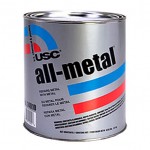
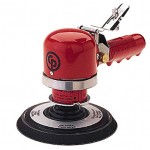
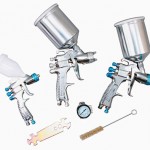
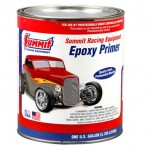
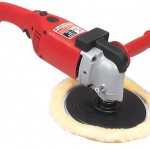
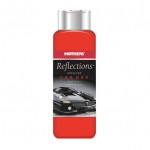
I’m a first timer on painting anything im painting my88 mustang lx 5.0 and imim trying to find out how to mix the primer sealer and hardener it says 5 parts sealer and one part heardener what does that mean I got a ratio cup 2 1/2 quart pail USC painters pailits got 1:10%:20 2:1:1 3:1:1 4:1:1 4:2:1 100:60:80 but no 5:1 so can somebody please tell them what to do please someone help me
If there is a row of just numbers and lines fill to 5 on primer and then to 6 with hardener. Or 10 with primer and 12 with hardener
[…] a six-part Automotive Paint Guide series that might be helpful here. You may want to check out our Paint and Bodywork Buyer’s Guide […]
[…] Paint Guide series that might be helpful here. You may want to check out our Paint and Bodywork Buyer’s Guide as […]